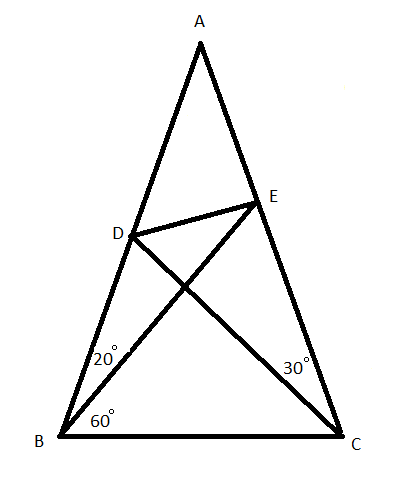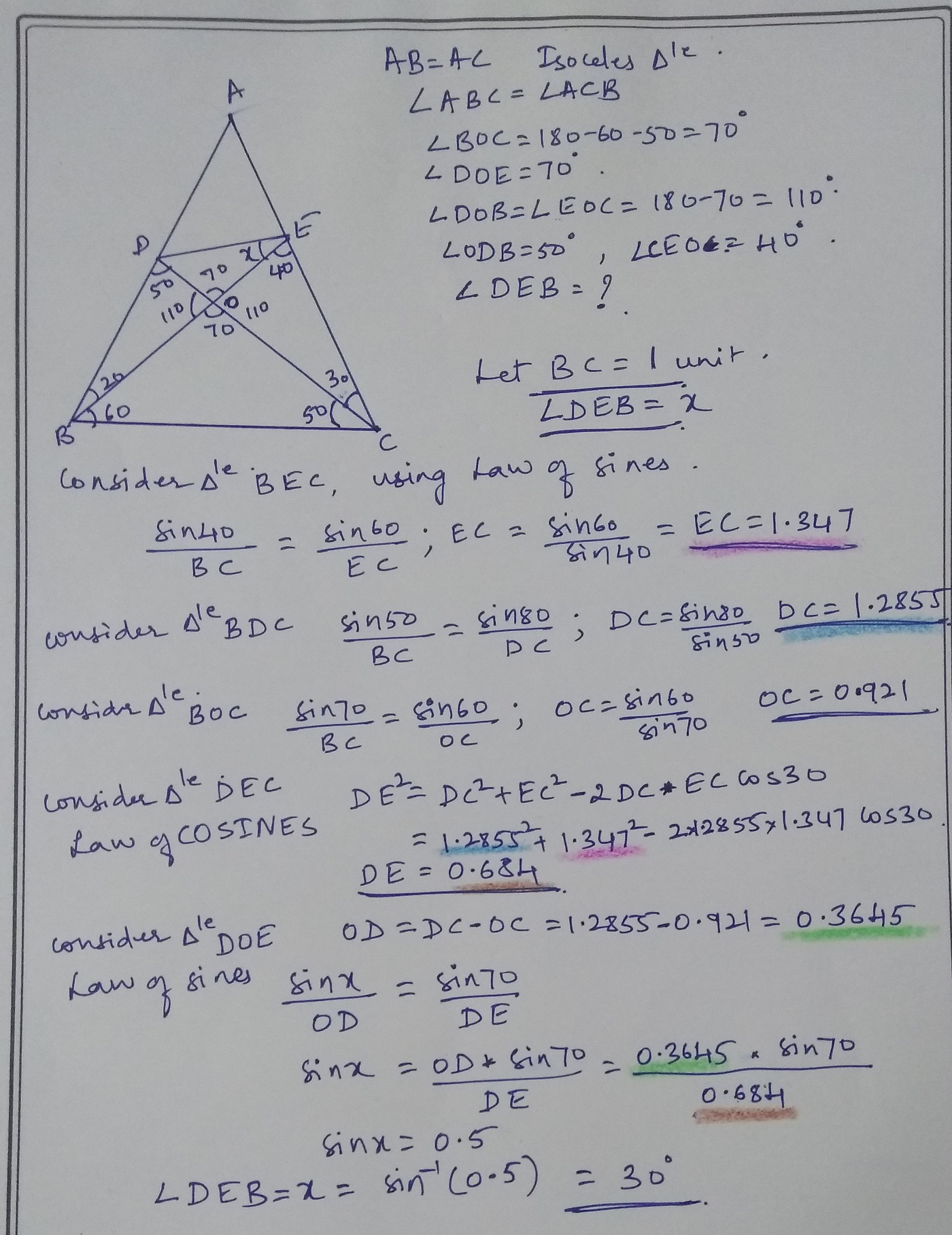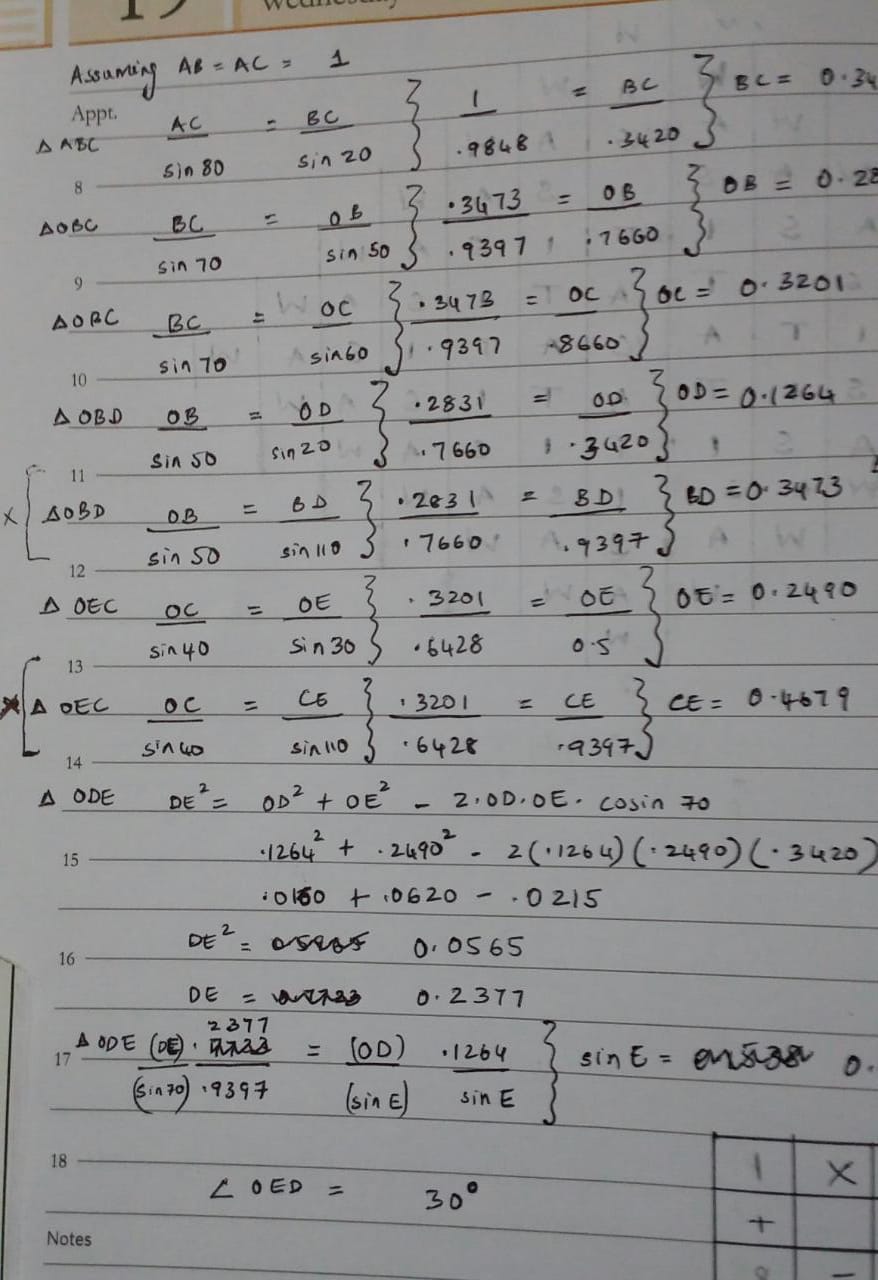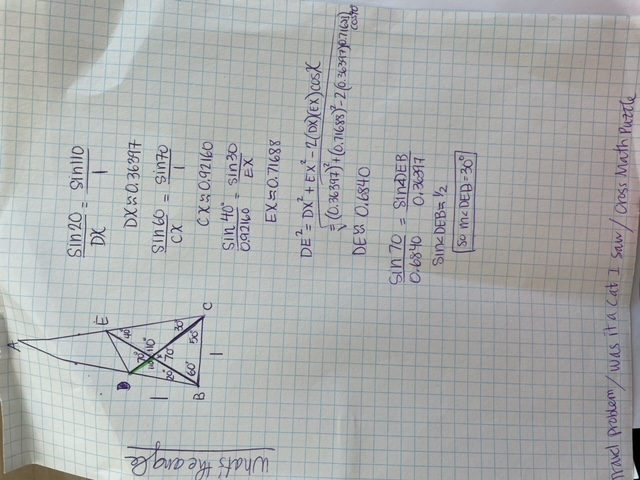ABC is an isosceles triangle in which AB = AC.
BE is a line segment intersecting angle B, such that angle DBE = 20° and angle CBE = 60°.
A line segment CD intersects angle C, such that angle ECD = 30°.
ED is Joined.
Determine the measure of angle DEB.
Show your work!

Solution to the Problem:
The measure of angle DEB = 30 degrees.
Draw segment BZ such that angle CBZ = 20 degrees.
Then draw segment DZ.

Draw segment BZ such that angle CBZ = 20 degrees.
Then draw segment DZ.

Since ABC is isosceles, angle ABC = angle ACB.
Since the measures of the 3 angles in a triangle add up to 180 degrees,
angle BCD = 50 degrees.
angle EBZ = 40 degrees since angle ABC = 80 degrees.
angle BZC = 80 degrees since the angles in a triangle add up to 180 degrees.
BZ = BC since angle BZC = angle BCZ.
angle BDC = 50 degrees since the angles in a triangle add up to 180 degrees.
BD = BC since angle BDC = angle BCD = 50 degrees.
so BZ = BD by the transitive property.
angle BDZ = angle BZD by the Isosceles Triangle Theorem.
That makes triangle BZD equilateral and angle BZD = angle BDZ = 60 degrees.
angle ZDC = 10 degrees and angle DZB = 60 degrees since the angles in a triangle add up to 180 degrees.
angle EZD = 40 degrees since the angles that form a line = 180 degrees.
angle DQB = 110 degrees since the angles in a triangle add up to 180 degrees.
angle EQC = 110 degrees since they are vertical angles.
angle DQE = angle BQC = 70 degees since the angles that form a line = 180 degrees.
angle BEZ = 40 degrees since the angles in a triangle add up to 180 degrees.
EZ = BZ from the Isosceles Triangle Theorem.
EZ = DZ by the transitive property.
angle ZDE = angle ZED = 70 degrees by the Isosceles Triangle Theorem and the angles in a triangle add up to 180 degrees.
angle DEB = 30 degrees since 70 - 40 = 30.
Since the measures of the 3 angles in a triangle add up to 180 degrees,
angle BCD = 50 degrees.
angle EBZ = 40 degrees since angle ABC = 80 degrees.
angle BZC = 80 degrees since the angles in a triangle add up to 180 degrees.
BZ = BC since angle BZC = angle BCZ.
angle BDC = 50 degrees since the angles in a triangle add up to 180 degrees.
BD = BC since angle BDC = angle BCD = 50 degrees.
so BZ = BD by the transitive property.
angle BDZ = angle BZD by the Isosceles Triangle Theorem.
That makes triangle BZD equilateral and angle BZD = angle BDZ = 60 degrees.
angle ZDC = 10 degrees and angle DZB = 60 degrees since the angles in a triangle add up to 180 degrees.
angle EZD = 40 degrees since the angles that form a line = 180 degrees.
angle DQB = 110 degrees since the angles in a triangle add up to 180 degrees.
angle EQC = 110 degrees since they are vertical angles.
angle DQE = angle BQC = 70 degees since the angles that form a line = 180 degrees.
angle BEZ = 40 degrees since the angles in a triangle add up to 180 degrees.
EZ = BZ from the Isosceles Triangle Theorem.
EZ = DZ by the transitive property.
angle ZDE = angle ZED = 70 degrees by the Isosceles Triangle Theorem and the angles in a triangle add up to 180 degrees.
angle DEB = 30 degrees since 70 - 40 = 30.
Veena Mg solved the problem using trigonometry. Here is her excellent solution:

Brijesh Dave also sent in an excellent trig solution to the problem:
Let m angle DEB = x
Using sine rule in triangle DEB
DE / sin 20 = BD / sin x = BE / sin (160-x)
Using sine rule in triangle BEC
BC / sin 40 = BE / sin 80 = EC / sin 60
BC = BE sin 40 / sin 80
But BC = BD in isosceles triangle BDC
BE (sin 40 /sin x sin 80) = BE / sin (160-x)
sin 40 /sin 80 = sin x / sin (160-x)
sin 40 sin (160-x) = sin x sin 80
sin 40 (sin160 cosx - cos160sinx) = sin x sin 80 [using sin(A-B)=sinA cosB – cosA sinB]
0.642[0.342cosx + 0.939sinx] = 0.984 sinx
0.219 cosx + 0.602sinx =0.984 sinx
0.984 sinx – 0.602 sinx = 0.219 cos x
0.382 sinx =0.219 cosx
sinx / cosx =0.219 / 0.382
tanx = 0.573
x= tan inverse 0.573
x = 30 degrees
Ivy Joseph also solved the problem using trigonometry. Here is her excellent solution:

Kelly Stubblefield also solved the problem using trigonometry. Here is her excellent solution:

Colin Bowey came up with a unique solution to the problem. Here is his excellent work:
Step 1. Add easily calculated additional internal angles by summing to 180.

Step 2.
Place the 80 20 80 isosceles triangle into a Nonagon and label the outer points with numbers.
Add any additional easily calculated angles summing to 140.

Step 3.
Extend Line D-E to the edges of the Nonagon to create a right angle on Line 2-3.
Label intersection of Lines D-E and 2-3 as G.

Step 4.
Extend Line B-E to the edge of the Nonagon at point 2.
Add any additional easily calculated angles.

Step 5.
Solution has presented itself as >DEB = >2EG Therefore angle DEB = 30°
Correctly solved by:
| 1. Colin (Yowie) Bowey | Beechworth, Victoria, Australia |
| 2. Veena Mg | Bangalore, Karnataka, India |
| 3. Brijesh Dave | Mumbai City, Maharashtra, India |
| 4. K. M. Thomas | Mumbai, Maharashtra, India |
| 5. Ivy Joseph | Pune, Maharashtra, India |
| 6. Dr. Hari Kishan |
D.N. College, Meerut, Uttar Pradesh, India |
| 7. Kelly Stubblefield | Mobile, Alabama |